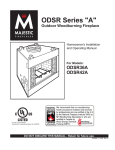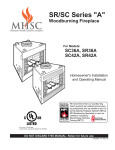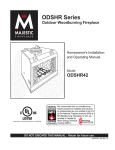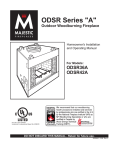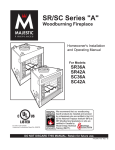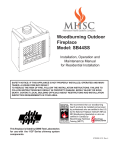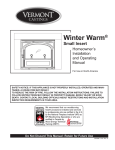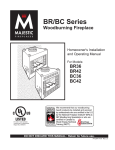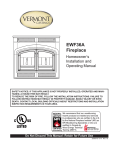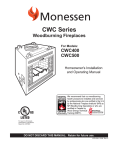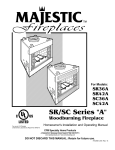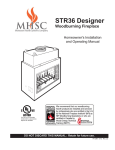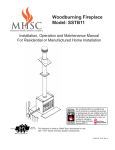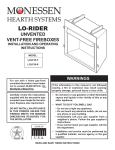Download Vermont Castings ODSR42A Specifications
Transcript
ODSR Series "A" Outdoor Woodburning Fireplace For Models: ODSR36A ODSR42A Homeowner's Installation and Operating Manual 948 SR cover 11/18/97 INSTALLER: Leave this manual with the appliance. CONSUMER: Retain this manual for future reference. 20006811 1/13 Rev. 15 ODSR Series "A" Outdoor Woodburning Fireplace Table of Contents Please read this manual before installing and using FIREPLACE. IMPORTANT: Read all instructions and warnings carefully before starting installation. Failure to follow these instructions may result in a possible fire hazard and will void the warranty. Safety Information Description. . . . . . . . . . . . . . . . . . . . . . . . . . . . . . . . . . . . . . . . . . . . . . . . 3 Precautions. . . . . . . . . . . . . . . . . . . . . . . . . . . . . . . . . . . . . . . . . . . . . . . . 3 Moisture Resistance. . . . . . . . . . . . . . . . . . . . . . . . . . . . . . . . . . . . . . . . . 3 Drafts . . . . . . . . . . . . . . . . . . . . . . . . . . . . . . . . . . . . . . . . . . . . . . . . . . . . 3 Gas Logs . . . . . . . . . . . . . . . . . . . . . . . . . . . . . . . . . . . . . . . . . . . . . . . . . 3 Cleaning . . . . . . . . . . . . . . . . . . . . . . . . . . . . . . . . . . . . . . . . . . . . . . . . . 3 Specifications and Framing . . . . . . . . . . . . . . . . . . . . . . . . . . . . . . . . . . . . . . . . 4 Hearth Dimensions. . . . . . . . . . . . . . . . . . . . . . . . . . . . . . . . . . . . . . . . . . 5 Chase Installation and Parts Identification . . . . . . . . . . . . . . . . . . . . . . . 5 Chimney Requirements . . . . . . . . . . . . . . . . . . . . . . . . . . . . . . . . . . . . . . 7 Planning Information. . . . . . . . . . . . . . . . . . . . . . . . . . . . . . . . . . . . . . . . . . . . . . 8 Moisture Resistance. . . . . . . . . . . . . . . . . . . . . . . . . . . . . . . . . . . . . . . . . 8 Mounting the Fireplace. . . . . . . . . . . . . . . . . . . . . . . . . . . . . . . . . . . . . . . 8 Planning the Chimney Run. . . . . . . . . . . . . . . . . . . . . . . . . . . . . . . . . . . . 8 The Ten Foot Rule . . . . . . . . . . . . . . . . . . . . . . . . . . . . . . . . . . . . . . . . . . 8 Chimney Supports . . . . . . . . . . . . . . . . . . . . . . . . . . . . . . . . . . . . . . . . . . 9 Chase Installation. . . . . . . . . . . . . . . . . . . . . . . . . . . . . . . . . . . . . . . . . . . 9 Installation . . . . . . . . . . . . . . . . . . . . . . . . . . . . . . . . . . . . . . . . . . . . . . . . . . . . . . 9 Insulating Fireplace Enclosure for Cold Climates. . . . . . . . . . . . . . . . . . . 9 Framing . . . . . . . . . . . . . . . . . . . . . . . . . . . . . . . . . . . . . . . . . . . . . . . . . 10 Chimney Setup. . . . . . . . . . . . . . . . . . . . . . . . . . . . . . . . . . . . . . . . . . . . 10 Straight-Up Chimney Installation . . . . . . . . . . . . . . . . . . . . . . . . . . . . . . 10 Offset Installation . . . . . . . . . . . . . . . . . . . . . . . . . . . . . . . . . . . . . . . . . . 10 Ceiling Chimney Hole/Possible Obstructions. . . . . . . . . . . . . . . . . . . . . 10 Cutting the Hole. . . . . . . . . . . . . . . . . . . . . . . . . . . . . . . . . . . . . . . . . . . 11 Framing the Ceiling Hole . . . . . . . . . . . . . . . . . . . . . . . . . . . . . . . . . . . . 11 Positioning, Safety Strips, Securing the Fireplace. . . . . . . . . . . . . . . . . 11 Installing Outside Air Kit. . . . . . . . . . . . . . . . . . . . . . . . . . . . . . . . . . . . . 12 Installing the Chimney System. . . . . . . . . . . . . . . . . . . . . . . . . . . . . . . . 12 Finishing. . . . . . . . . . . . . . . . . . . . . . . . . . . . . . . . . . . . . . . . . . . . . . . . . 14 Side Wall Protection. . . . . . . . . . . . . . . . . . . . . . . . . . . . . . . . . . . . . . . . 16 Hearth Installation. . . . . . . . . . . . . . . . . . . . . . . . . . . . . . . . . . . . . . . . . . 16 Installing Line for Gas Logs . . . . . . . . . . . . . . . . . . . . . . . . . . . . . . . . . . 18 Replacement Parts . . . . . . . . . . . . . . . . . . . . . . . . . . . . . . . . . . . . . . . . . . . . . . 19 Accessories . . . . . . . . . . . . . . . . . . . . . . . . . . . . . . . . . . . . . . . . . . . . . . . . . . . 20 Chimney Components . . . . . . . . . . . . . . . . . . . . . . . . . . . . . . . . . . . . . . . . . . . 21 Warranty. . . . . . . . . . . . . . . . . . . . . . . . . . . . . . . . . . . . . . . . . . . . . . . . . . . . . . . 23 ODSR36A / ODSR42A Listed UL 127 / ULC-S610 Standard for Factory Built Fireplaces Proposition 65 Warning: Fuels used in gas, woodburning or oil fired appliances, and the products of combustion of such fuels, contain chemicals known to the State of California to cause cancer, birth defects and other reproductive harm. California Health & Safety Code Sec. 25249.6 20006811 ODSR Series "A" Outdoor Woodburning Fireplace Safety Information NOTE: These units are intended for outdoor or indoor use in the United States and Canada using the 'SK' chimney system. These units may also be used outdoors or indoors in the United States and Canada using the 'S' chimney system with an adapter. Description The ODSR Series "A" fireplaces are clean-faced, solid fuel, woodburning fireplaces. Precautions Vermont Castings Group Fireplaces and component parts have been highly tested and will operate safely when installed in accordance with instructions provided in this manual. Carefully read and understand all instructions before beginning installation. If you notice any damage to fireplace or component parts, immediately report damage to your Vermont Castings Group dealer. Only use Vermont Castings Group components or the warranty will be voided and a fire hazard may be created. Vermont Castings Group warranty will be voided by and Vermont Castings Group disclaims any responsibility for the following actions: • Installation of any damaged fireplace or chimney component; • Modification of fireplace, chimney assembly or any component parts thereof; (except for chase flashings as detailed in Vermont Castings Group Chimney Top installation instructions). • Installation other than as instructed by Vermont Castings Group; or • Installation and/or use of any component part not manufactured or approved by Vermont Castings Group in combination or assembly with a Vermont Castings Group fireplace system, notwithstanding any independent testing laboratory or other third party approval of such component parts or accessory. Any such action may possibly cause a fire hazard. Consult local building codes to ensure that you are in compliance before installing the fireplace. Fireplaces must be vented to the out-of-doors. WARNING: To avoid the risk of damaging fireplace materials and increasing the risk of spreading a fire, do not use the fireplace to cook or warm food. Do not obstruct or modify air inlets/outlets in any manner. Do not install combustible materials on any of the fireplace surround. Burn only solid wood fuel or gas logs. Do not install a solid fuel burning insert or other products not specified for use with this fireplace. These fireplaces are not approved for installation in mobile homes. 20006811 This fireplace is not designed to be water tight. Therefore, when installing this unit against an exterior wall, the wall must be finished before setting unit in place. Moisture Resistance This outdoor fireplace will shed moderate amounts of water, but is not waterproof. Water and condensing water vapor may enter the chase under certain conditions. The fireplace will not perform as an exterior wall. Moisture penetration must be considered for construction that places the fireplace in structure walls or on moisture sensitive surfaces. When installed on exterior walls: Vermont Castings Group recommends the fireplace chase be constructed outside the structure's weather envelope. Where the platform meets the wall, use a flashing detail similar to that required for attached decks. Chase platforms, including hearths should slope away from the structure at 1/4 in per foot. The fireplace can be shimmed level. When installed on surfaces where water may collect or cause damage: Vermont Castings Group recommends a slope of 1/8 in to 1/4 in per foot towards the drain port suggested. The fireplace can be shimmed level. Hearths should slope away from the front of the fireplace and chase at 1/8 in to 1/4 in per foot. Metal safety strips must be on top of any combustible hearth materials used for moisture management. Drafts The fireplace should not be located in areas that create drafts (ie: frequently opened doors and central heating air inlets/outlets) that hamper the normal flow of air into the fire. Gas Logs If you plan to install a gas log, the gas line should be installed before framing the fireplace. The gas line must be installed by a certified gas line installer. Cleaning There are three methods of cleaning the polished stainless steel of your outdoor fireplace; 1. Warm, soapy water - to loosen any dirt film 2. Glass cleaner with ammonia 3. Stainless steel cleaner available at hardware stores Regardless of which method is used, remember that anything with too much abrasive may dull the finish. ODSR Series "A" Outdoor Woodburning Fireplace ODSR36A Series Woodburning Fireplace Minimum Rough Opening Depth 4856O" (1232 mm) 1/2" (13 mm) 22" (559 mm) 2256O" (572 mm) 11" Dia. (279 mm) 856M" (210 mm) 8" Dia. (203 mm) 5/8" Recessed (16 mm) Nailing Flange 56O 5 " ( /8 17 " ( 40 16 m mm m ) ) m 6 87 56O "( 34 1/2" Minimum Rough Opening Height Minimum Rough Opening Width 41" (1041 mm) 68 4856O" (1232 mm) m ) 22" (559 mm) 396" (1006 mm) 756O" (191 mm) 436M" (1111 mm) Outside Air 756O" (191 mm) Gas Line Access 24" (610 mm) 36" (914 mm) 226M" (578 mm) 146" (372 mm) 11" (279 mm) 8" (203 mm) Gas Line Access 76M" (197 mm) 40" (1016 mm) Fig. 1 ODSR36A specifications and framing. 6811 ODSR42A Woodburning Fireplace — Circulating Model Minimum Rough Opening Depth 11" Dia. (279 mm) 856M" (210 mm) m 56O ) "( 17 5 91 /8" m (16 m m ) m ) 2256O" (572 mm) 22" (559 mm) m 4 "( 91 36 1/2" Minimum Rough Opening Height Minimum Rough Opening Width 47" (1194 mm) 8" Dia. (203 mm) 5/8" Recessed (16 mm) Nailing Flange 70 50" (1270 mm) 50" (1270 mm) 1/2" (13 mm) ODSR36 specs 9/03 2656M" (667 mm) 756O" (191 mm) 436M" (1111 mm) 396" (1006 mm) Outside Air 756O" (191 mm) Gas Line Access 11" (279 mm) 8" (203 mm) 42" (1067 mm) 146" (372 mm) 226M" (578 mm) 24" (610 mm) Gas Line Access 76M" (197 mm) 46" (1168 mm) Fig. 2 ODSR42A specifications and framing. FP591 SR42 SPECS 10/28/98 7/6/99 djt correct dims. 20006811 ODSR Series "A" Outdoor Woodburning Fireplace NOTE: When installation is on a hard, flat surface (such as concrete), the surface must be sloped 1/4" per foot away from any structure. B C A Blocking FP1531 Front Width Back Width A B Depth ODSC42A 31¹⁄₈" FP153119⁷⁄₈" 15¹⁄₂" hearth dimensions (791 mm) (505 mm) (394 mm) 9/04 djt 36³⁄₄" 22⁷⁄₈" 15¹⁄₂" (934 mm) ODSR36A (581 mm) 1/2” (13 mm) C 394 mm) Fig. 3 Hearth dimensions. Metal Safety Strips Hard, Flat Surface (i.e. concrete) Chase Installation Insulation methods shown are optional for cold climate, not a requirement for unit operation or exterior installation . Interior Chase Installation FP1642 concrete install 9/06 Exterior Chase Installation Termination Cap Storm Collar Pan Flashing Termination Cap Storm Collar Pan Flashing Batt Insulation (cut out around firestop) Exterior Siding Exterior Siding Draftstop Firestop FP1642 Fig. 4 Exterior chase installation. Ceiling Level Interior sides of chase should be weather proof Ledge Bracket Surround Damper Control Gas Line Knockout (both sides) Screen Grate Firebox Metal Safety Strips (1,2 or 3) Ledge Bracket Surround Damper Control Standoff Gas Line Knockout (both sides) Screen Gas Line Access (both sides) Grate Firebox Metal Safety Strips (1,2 or 3) Outside Air Cover Plate FP554 Fig. 5 Fireplace and chase parts identification. FP554 BR/BC Combo of IWF261 AND IWF265 11/10/97 20006811 Gas Line Access (both sides) Outside Air Cover Plate FP1641a FP1641a exterior chase installation 9/06 ODSR Series "A" Outdoor Woodburning Fireplace NOTE: If the fireplace is a freestanding unit, it must be located a minimum of 10' (3 m) from the opening of the firebox to a combustible structure. A minimum height of 6'4" (1.9 m) measured from the base of the firebox to the bottom of the termination cap is permitted. 10' (3m) Min. 6'4" (1.9m) Min. FP1001 Fig. 6 Freestanding installation. FP1001 fireplace setting 1/4/00 djt 20006811 ODSR Series "A" Outdoor Woodburning Fireplace Chimney Requirements - Offset Installations OFFSET CHIMNEY FLUE EXIT RISE CHIMNEY SECTION A D E 6 FT. C G 30˚ OFFSET ELBOW RISE H OFFSET 30˚ RETURN ELBOW 30˚ OFFSET ELBOW B 30° Elbow Offsets Chimney Support ELBOW B FP282 30˚ RETURN ELBOW 1' 1¹⁄₂' 3' 4' G 0 0 0 0 0 SKCS8 SUPPORT H HEARTH FLOOR Example 1 Example 2 Example 3 Notes: G + H cannot exceed 20 feet. Air Space Clearances: SK8 (2-wall) = 1¹⁄₂" and "S" Series (3-wall) = 2" Illustration Key IWF269 FP269 MBUF 5/16/96 chimney rev. 5/25 The following safety rules apply to offset installations (letters correspond with illustration above): C. The cannot be more than 30° (45° in Canada) from the vertical plane in any installation*. A. Height of the chimney is measured from the hearth to the chimney exit. D. The maximum length of the angled run of the total chimney system is 20 feet. (G plus H cannot exceed 20 feet.) ODSR36A ODSR42A Maximum: 90'0" 90'0" Minimum: Without Elbows 12' 6" 12' 6" With 2 Elbows* 14' 6" 14' 6" With 4 Elbows* 21' 0" 21' 0" B. Do not use more than 4 elbows per chimney. Attach the straps of the return (top) elbow to a structural framing member. The offset (first) elbow of any pair does not have straps. * In Canada, two (2) SK845 are allowed. E. A chimney support (Model SKCS8) is required every 6 feet of angled run of chimney. Chimney supports are required for every 30 feet and 60 feet (SK8 pipe) or 20 feet and 40 feet (3-wall pipe) of vertical chimney height above the hearth. Determine the offset distance of your chimney arrangement from the centerline of the fireplace to the centerline of the chimney where it is to pass through the first ceiling. Note: This offset distance may not be your full offset distance. See Examples 2 and 3. 1 0 2 1 0 2 0 0 1 0 0 1 0 0 0 0 0 0 0 0 0 0 0 0 0 0 0 0 0 0 0 0 0 0 0 0 0 0 0 0 1 0 1 0 1 0 1 0 1 0 1 0 1 0 1 0 1 0 1 0 1 0 1 0 1 0 1 0 1 0 1 0 1 0 1 0 1 0 0 0 0 0 1 0 0 1 0 0 2 0 1 2 0 1 3 0 2 3 1 2 0 1 3 0 2 3 1 2 0 1 3 0 2 3 1 2 0 0 0 0 0 0 0 1 0 1 1 0 1 1 0 2 1 0 2 1 0 2 1 3 2 1 3 2 1 3 2 4 3 2 4 3 2 4 3 5 FP282 MBUF Offset5/26/96 Rise 3" 0 8¹⁄₄" 0 11¹⁄₄" 0 13¹⁄₂" 0 16¹⁄₂" 0 20¹⁄₄" 0 21³⁄₄" 0 26¹⁄₄" 0 28¹⁄₂" 0 31¹⁄₂" 0 34¹⁄₂" 0 37¹⁄₂" 1 41¹⁄₂" 1 45" 1 47¹⁄₄" 1 51" 1 53¹⁄₄" 1 56¹⁄₄" 1 59¹⁄₄" 1 62¹⁄₄" 1 64¹⁄₂" 1 68¹⁄₄" 1 70¹⁄₂" 1 74¹⁄₄" 2 78" 2 81" 2 84" 2 87" 2 89¹⁄₄" 2 93" 2 95¹⁄₄" 2 99¹⁄₄" 2 101¹⁄₄" 2 104¹⁄₄" 2 107¹⁄₄" 2 110¹⁄₄" 3 114" 3 117³⁄₄" 3 120" 3 123³⁄₄" 11" 20" 25¹⁄₄" 29¹⁄₄" 34¹⁄₄" 40³⁄₄" 43¹⁄₂" 51¹⁄₄" 55¹⁄₄" 60¹⁄₄” 65¹⁄₂" 70³⁄₄" 77³⁄₄" 83³⁄₄" 87¹⁄₂" 94" 98" 103¹⁄₄" 108¹⁄₂" 113¹⁄₂" 117¹⁄₂" 124" 128" 134¹⁄₂" 140³⁄₄" 146" 151¹⁄₄" 156¹⁄₂" 160¹⁄₄" 166³⁄₄" 170³⁄₄" 177³⁄₄" 181³⁄₄" 186¹⁄₄" 191¹⁄₂" 196³⁄₄" 203¹⁄₄" 209³⁄₄" 213¹⁄₂" 220" Fig. 7 Chimney system requirements. 20006811 ODSR Series "A" Outdoor Woodburning Fireplace Planning Information Preplanning an installation is very important to ensure safety and to save time and money. An installer must predetermine where a fireplace will be set and how the chimney system will be run. LT Moisture Resistance L1 This outdoor fireplace will shed moderate amounts of water, but is not waterproof. Water and condensing water vapor may enter the chase under certain conditions. L1 The fireplace will not perform as an exterior wall. Moisture penetration must be considered for construction that places the fireplace in structure walls or on moisture sensitive surfaces. When installed on exterior walls: Vermont Castings Group recommends the fireplace chase be constructed outside the structure's weather envelope. Where the platform meets the wall, use a flashing detail similar to that required for attached decks. Chase platforms, including hearths should slope away from the structure at 1/4 in per foot. The fireplace can be shimmed level. When installed on surfaces where water may collect or cause damage: Vermont Castings Group recommends a slope of 1/8 in to 1/4 in per foot towards the drain port suggested. The fireplace can be shimmed level. Hearths should slope away from the front of the fireplace and chase at 1/8 in to 1/4 in per foot. Metal safety strips must be on top of any combustible hearth materials used for moisture management. Mounting the Fireplace A fireplace may only be mounted on the following surfaces: 1. A flat combustible surface. 2. A raised wooden platform. 3. A concrete block or other solid object placed beneath each of the four (4) corners of the fireplace. The fireplace must be spaced 1/2" (13 mm) from a combustible back wall and 1/2" (13 mm) from a combustible side wall or support. (Page 21, Fig. 21) Planning the Chimney Run Determine how the chimney will be run, length of run and chimney components required to complete the job. (Fig. 8) Never install a chimney below minimum heights. MODEL SK 2 WALL CHIMNEY TOTAL LENGTH (LT) INSTALLED LENGTH (L1) SK81 SK818 SK83 SK84 1156O" 1756O" 3556O" 4756O" 1056O" 1656O" 3456O" 4656O" WF288 Fig. 8 Installed lengths of chimney sections. FP288 3. A chimney may run straight up or it may be necessary MBUF-INSTALLED LENGTH to offset it to avoid obstructions. 6/17/96 4. The maximum length of an angled run (total chimney system) is 20' (6 m). 5. No more than 2 offsets (4 total 30° elbows in U.S./or 2 total 45° elbows in Canada) per fireplace may be used. 6. A guy wire stabilizer is required for chimneys extending more than 6' (1.8 m) above a roof line. The Ten Foot Rule Major U.S. building codes specify a minimum chimney height above the roof top. The “Ten Foot Rule” is a fire safety rule and not a draft rule. To ensure proper draft, it is recommended that you always meet or exceed the “Ten Foot Rule,” especially when installing a termination on a high pitch roof. (Fig. 9) The key points of the "Ten Foot Rule" are: 1. If the horizontal distance from the chimney to the peak of the roof is 10' (3 m) or less, the top of the chimney must be at least 2' (610 mm) above the peak of the roof, but never less than 3' (914 mm) in height above the highest point where it passes through the roof. 2. If a horizontal distance from the chimney to the peak of the roof is more than 10' (3 m), a chimney height reference point is established on the surface of the roof a distance of 10' (3 m) from the chimney in a horizontal plane. The top of the chimney must be at least 2' (610 mm) above the reference point, but never less than 3' (614 mm) in height above the highest point where it passes through the roof. In planning a chimney system, it is important to know: 1. The height of a chimney is measured from the hearth to the exit point on the termination. 2. A chimney cannot be offset more than 30° from a vertical plane. 20006811 ODSR Series "A" Outdoor Woodburning Fireplace Installation 0 To 10' 2' Min. Insulating Fireplace Enclosure for Cold Climates 0 To 10' 3' Min. 2' Min. If you live in a cold climate, it is not required but highly recommended that you insulate fireplace enclosure to eliminate cold air penetration as much as possible. 3' Min. Reference Point AC246 Fig. 9 Ten Foot Rule illustration. AC246 Chimney Supports 4/1/96 The chimney system is supported by the fireplace for vertical chimney heights less than 30' (9 m) above the hearth. Chimney supports are required if the vertical height exceeds 30' (9 m) with SK8 chimneys or 20' (6 m) with 3-wall chimneys. Locate chimney supports at ceiling holes or other structural framing at 30' (9 m) (SK8) or 20' (6 m) (3-wall) heights. Spacing between chimney supports must not exceed 30' (9 m) (SK8) or 20' (6 m) (3-wall). Use Chimney Support Model SKCS8. (Note: The SKCS8 can not be mounted directly to the fireplace.) Support provided by elbow straps fulfills the support requirement only if they are spaced as previously described. (A chimney support is 2¹⁄₂" (64 mm) long when installed.) Angled chimney runs require a support every 6' (1.8 m) in addition to the elbow straps. Chimney supports are used for this function. (Fig. 10) Chase Installation Insulate base of fireplace with a noncombustible insulation rated for a minimum of 300°F. Insulating is very important for outside wall installations over a concrete slab. If fireplace is installed on a platform, insulation should be placed on top of the platform before fireplace is set. (Fig. 11) When a fireplace is installed in a chase or on an outside wall, enclosure should be treated like any outside wall in a home. Insulation should be installed on the inside wall as well as the outside wall(s). In a chase, it is also a good idea to install a firestop at the first ceiling level above the fireplace and enclose the chase with sheeting material. Insulation may then be installed above sheeting material to assure the space around the fireplace is totally protected. (Fig. 5) When installing the chimney, DO NOT caulk between outer pipe and firestop. It is vital that some air be allowed to flow through this very thin gap. CAUTION: WHEN INSTALLING A FIREPLACE IN AN INSULATED ENCLOSURE, BE SURE ALL REQUIRED AIR SPACES ARE MAINTAINED. (Page 21, Fig. 21) A chase is a vertical boxlike structure which encloses the fireplace and/or chimney. Chases are typically built on the outside of the house with fireplace opening cut into the outer wall of a room. (Page 5, Fig. 5) Hard Flat Surface If you need help in determining fireplace location or how the chimney system should be run, contact your Vermont Castings Group dealer for assistance. Insulation Chimney Support Strap SKCS8 Platform FP555 FP284 Fig. 11 Insulating between platform and fireplace. Fig. 10 Chimney support installation 20006811 FP284 MBUF 5/25/96 FP555 BR 11/10/97 ODSR Series "A" Outdoor Woodburning Fireplace Framing Framing can be constructed before or after the fireplace is set in place, however, most installers build the frame before setting the fireplace. Frame fireplace with 2 x 4 lumber or heavier materials. Refer to framing dimensions in Figures 1, 2, 3 or 4 for basic fireplace specifications. Chimney Centerline Actual Centerpoint 9 ¹⁄₄" (235mm) Note: Framing should be positioned to accommodate wall covering and fireplace facing material. Chimney Setup Since you have already preplanned the chimney run, you should know exactly how the installation is to be accomplished — how much pipe is required, the number of elbows, if any, and type of termination to be used. Plumb Line Plumb Bob Imaginary Centerpoint CAUTION: REPORT TO YOUR DEALERS ANY PARTS DAMAGED IN SHIPMENT, SPECIFICALLY CHECK THE END CONNECTION OF CHIMNEY SECTIONS AND ELBOWS. NOTE: Fireplaces may use Vermont Castings Group model SK8, or Model S (three wall) chimney systems. The ODSR Series "A" Fireplace will accept the SK8 chimney system as is; but a TWABR adapter collar is required when using the Model S (triple wall) chimney system. The installation procedure described in this manual applies only to the SK8 system. Either chimney system may be used, but may not be mixed. Straight-Up Chimney Installation To mark the centerline of the flue, put the fireplace in final position and measure out from the wall: 9¹⁄₄" (235 mm). Mark a spot on the ceiling directly above the fireplace. Draw a line parallel to the back wall through this mark. (Fig. 12) Using a plumb bob positioned directly over center point of fireplace flue collar, mark the ceiling to establish the chimney center point. (Fig. 12) FP556 Fig. 12 Locate centerline of chimney with plumb line. Determine offset distance of your chimney arrangement from centerline of fireplace to centerline of chimney where it is to pass through ceiling. Offset Installation Locate center point of the chimney on ceiling as though a straight up chimney arrangement is to be used. Measure your offset dimension from straight up chimney center FP556 point on ceiling. In order to clear an obstruction, it may be necessary to offset chimney from vertical. This is accomplished by using Vermont Castings Group elbows. Use the 30° Offset Elbow table on Page 5 to determine proper offset and parts required. The size of the hole in ceiling will vary with the angle at which the chimney passes through ceiling. Each offset requires two (2) elbows. The second elbow is equipped with support straps. It is very important to install the second elbow in each offset as close to the ceiling or support as possible so that the elbow straps can be secured to framing members to help support the weight of the chimney. 10 BR/BC LOCATE CENTER LINE Ceiling Chimney Hole/ 11/10/97 Possible Obstructions Drive a nail up through ceiling at marked chimney center point. Go to floor above and see where hole will be cut. Check to see where existing ceiling joists and other possible obstructions are located...i.e. wiring, plumbing etc... If necessary, reposition chimney and/or fireplace to avoid obstructions. 20006811 ODSR Series "A" Outdoor Woodburning Fireplace Cutting the Hole Cover fireplace collar opening and cut proper sized chimney hole in chimney. The SK8 pipe allows you to run pipe through a typical 16” on center joist without cutting joists. Metal Safety Strips (1, 2 or 3 pieces) Framing the Ceiling Hole Frame the ceiling chimney hole as shown in Figure 14. It is good practice to use framing lumber that is the same size as the ceiling joists; this is a requirement at attic level. The following table gives firestop spacer model numbers: Angle of Chimney at Ceiling Size of Chimney Vertical 30° 8" Flue SKFS2A SKFS6A "SK" Series 14¹⁄₂" x 14¹⁄₂" 14¹⁄₂" x 25¹⁄₂" (368mm x 368mm) (368mm x 648mm) 8" Flue FS2A FS6A "S" Series 3-Wall 17¹⁄₂" x 17¹⁄₂" 17⁷⁄₈" x 29⁵⁄₈" (445mm x 445mm) (454mm x 753mm) Fig. 13 Ceiling chimney hole sizes necessary for installing firestop spacer. The inside dimension of the frame must be the same as the hole size selected from Figure 13 in order to provide required the 1¹⁄₂" (38 mm) of air space between the outside diameter of the chimney and the edges of the framed ceiling hole. Existing Ceiling Joist AB AB "Z" Safety Strip (not supplied) Fireplace FP557 1¹⁄₂" 1/2" Min. Overlap Platform Hearth Ext. Fig. 15 Safety strip installation. Safety strips are used to ensure that any combustible maFP557 even though terials in front of the fireplace are protected BRrequired. a noncombustible hearth extension is 11/10/97 If fireplace is to be elevated above the floor, a “Z” shaped metal safety strip must be fabricated and used to protect combustible surfaces in front of the fireplace. This “Z” shaped safety strip is not provided but must be fabricated of metal with each horizontal leg at least 1¹⁄₂" (38 mm) wide and equal in length to the metals strips provided with the fireplace. NOTE: Safety strips are not required over noncombustible floors where all supports at the base of the fireplace are noncombustible. Four (4) nailing flanges are incorporated on each corner of the surround. Bend the nailing flanges out, level the box, then secure it firmly in place by nailing the flanges to the framing members as shown in Figure 16. Chimney Hole Ceiling Nail Top Standoffs New Framing Members A "SK" Series framing = 14¹⁄₂" X 14¹⁄₂" (368 x 368mm) B "S" Series framing = 17¹⁄₂" X 17¹⁄₂" (445 x 445mm) Nail SideNailing Flanges FP551 Fig. 14 Typical frame for ceiling chimney hole. FP551 BR/BC 9/29/97 Positioning, Safety Strips, Securing the Fireplace Slide fireplace into position. Lift the fireplace front slightly and slide the metal safety strips under front bottom edge about 1¹⁄₂" (38 mm), allowing the remainder to extend in front of firebox. Overlap strips at least 1/2" (13 mm) to provide a positive joint. (Flat safety strips are packed with fireplace.) (Fig. 15) 20006811 FP549 Fig. 16 Fasten fireplace in position. FP549 9/29/97 BR/BC 11 ODSR Series "A" Outdoor Woodburning Fireplace Installing Outside Air Kit Elbow Strap An outside air kit is not installed in all ODSR Series "A" Fireplaces. If desired, or if local codes mandate the use of an air kit, then an AKU1 is required . If the outside air kit is to be used, the AKU1 MUST be installed BEFORE the fireplace is enclosed. Refer to the AKU1 instructions for field installation. NOTE: For Canada installations, model CCE-SK Chimney Collar Enclosure must be used on this fireplace with Model SK8 double wall chimney systems. Elbow Strap (must be tight) Ceiling Hole Framing Angled Strap Installing the Chimney System Angle Firestop Start by attaching the first chimney section to the collar on top of the fireplace. Install the pipe as pictured in Figure 17. When you get a good lock, you will hear the pipe clearly snap together. Once sections are snap-locked in place, it is extremely difficult to get them apart. Make sure the pipe is firmly snapped and locked together as each pipe section is mounted. Pipe Rim Hem Pipe Rim Chimney Support Strap (must be tight) FP270/271 FP270/271 Fig. 18 Attach straps to a structuralCR framing Seriesmember. 2/19/99 djt Nail the firestop spacer (at each corner) to the framing members of the ceiling hole. NOTE: A firestop spacer is not required at the roof. Hole sizes listed in Figure 13 for angled firestop spacers provide minimum required air space to chimney pipe for ceiling thickness up to 8" (203 mm). When combined thickness of ceiling material, ceiling joists and flooring material exceeds 8" (203 mm), adjustments must be made in framing to assure that minimum air spaces to chimney are maintained. Pipe Section UP Support Structure Lance Proper Firestop Spacer Installation Figure 19 shows different installation procedures for both an area that is an attic and an area that is not an attic. If the area above the ceiling is not an attic, position the firestop spacer with the flange on the ceiling side and the angled portion extending up into the hole. FP558 Fig. 17 Install pipe, listening for the snap-lock to fasten. When installing elbows, only outer pipe will snap- lock. Middle pipes simply slide into position. Be sure to always attach straps on upper elbow to a structural framing member. (Fig. 18) Continue installing the pipe as required until pipe is installed up through the ceiling. At this point, you must install a firestop spacer. FP558 BR 11/10/97 Spacer Installing the Firestop in the Ceiling Hole A firestop spacer is used to keep pipe spaced properly and required for safety. 12 If the area above the ceiling is an attic, position the firestop spacer with the flange on the top of the framed hole and the angled portion extending down into the hole. Firestop spacers are not available for nor are they required on vertical walls. DO NOT put any sealant around the area where the outer pipe slides through the firestop spacer. If you seal this area, it may cause a fire hazard. Canadian Requirements for Insulation Shield In Canada, an attic insulation shield is required to prevent attic insulation from contacting the chimney section. Framing dimensions for the chimney hole should measure 14¹⁄₂" x 14¹⁄₂" (368 x 368 mm). An attic shield MUST be installed on top of attic joists (above the floor level). (Fig. 20) 20006811 ODSR Series "A" Outdoor Woodburning Fireplace Chimney Supports Attic Installation If chimney supports are required, they are installed the same as elbows. Nail chimney support straps to adjacent structural framing, as shown on, Page 9, Figure 10. Bend straps as necessary and make sure they are secure so they will support the weight of the chimney. A chimney support is 2¹⁄₂" (64 mm) long when installed. Consider this dimension when determining how many straight chimney sections are needed. Nails (4) Firestop Spacer Joist NOTE: Chimney supports are generally used in long runs in a chase installation. Ceiling Installation Additional Ceilings If you encounter additional ceilings, repeat same steps required for first ceiling installation. Refer to firestop illustration on Figure 19. Joist Penetrating the Roof Firestop Spacer Nails (4) Run pipe to roofline. Since chimney system must be vented to the out-of-doors, you must use an approved Vermont Castings Group termination. FP593 Fig. 19 Installing firestop spacer. Attic Insulation Shield Locate Chimney Centerpoint On Roof Use same procedure detailed in locating centerpoint of the flue system. FP593 SR/C 11/20/97 Drive a nail up through roof at the center point. This will determine center point on outside of the roof. Nails (4 required) Attic Joist Ceiling Base Flanges FP263 Fig. 20 Attic shield installlation (Canadian requirement). Install the attic insulation shield with the flanges on its base extending down into theFP263 framing hole. Nail each corner of attic insulation shield toMBUF the framing members of the ceiling hole using 8d nails.5/9/96 Attic shields are not required at the roof. Continue Installing Pipe to Complete Run Continue attaching pipe sections to complete system to next level always being careful that the pipe is firmly snapped locked in place before proceeding to next pipe section. 20006811 If a chase is used, refer to the installation manual provided with the termination cap. Cut and Frame Roof Hole Size of roof hole varies with the type of chimney termination installed. Refer to installation instructions provided with Vermont Castings Group chimney termination to find correct size of roof hole. There must be a 1¹⁄₂ (38 mm) air space between outermost portion of chimney sections and any adjacent combustible surfaces. (Combustible surfaces include burnable materials such as: ceiling members, joists, flooring, combustible insulation and roof structures.) WARNING: DO NOT PACK REQUIRED AIR SPACES WITH INSULATION OR OTHER MATERIALS. Mark an outline of the roof hole around the center of the point nail. NOTE: Hole dimensions given in the chimney top installation instructions are horizontal dimensions; therefore, the hole size must be marked on the roof accordingly. Cover the opening of the installed chimney so debris cannot get into the system. 13 ODSR Series "A" Outdoor Woodburning Fireplace Cut and frame the hole. It is good practice to use framing lumber that is the same size as the rafters. Install the frame securely because the chimney top and flashing anchored to the frame must be able to withstand heavy winds. Air Space Clearances Combustible framing material MUST NOT penetrate AIR SPACE (shaded areas). Install Remainder of Chimney Sections Since you have already preplanned the height of your termination according to the Ten Foot Rule, continue to install pipe to the predetermined height. Check the chimney top installation instructions for details on how high above the roof top the chimney sections (all pipes) should extend. Installing Top Housing or Termination Follow the installation instructions provided with the chimney termination you have selected. 1¹⁄₂" Standoff ¹⁄₂" air space to sides Front View Side View Firestop Installing Chimney In a Chase Refer to Page 5, Figure 5 for an illustration of a typical chase installation. Wall Shield ¹⁄₂" Air Space to Back CAUTION: Treatment of firestop spacers and construction of chase may vary with type of building. These instructions are not a substitute for local building codes. You must check your local building codes to determine specific requirements for your city or state. NOTE: Other building materials may be required in addition to Vermont Castings Group Firestop Spacers. ¹⁄₂" Air Space to Sides Finishing CAUTION: All joints between the finished wall and the fireplace surround (top/sides) must be sealed with noncombustible material to prevent cold air leakage into the room. Only noncombustible material may be applied to the facing of the fireplace surround. (Black painted area) (Fig. 21) Finish Wall Finish the wall with material of your choice. Do not install a combustible mantel shelf less than 12" (305 mm) from the top of the fireplace opening. Do not install a mantel face plate less than 6" (159 mm) from top of fireplace opening. (Fig. 23) If a combustible material is used below a flat mantel shelf, consult your local building codes for minimum clearance from top of fireplace opening to bottom of mantel shelf. Only noncombustible material may be applied as facing to the black fireplace surround. 0" Clearance to Floor Hearth Extension FP559 Fig. 21 Minimum clearances to combustibles. FP559 is required for fireplaces NOTE: No side wall protection installed at 45° to two (2)BR/BC-AIR side walls SPACES (corner installation). 11/10/97 Often a decorative surround or vertical portion of the mantel is desired. If this is constructed of any combustible material it must be within the safe zone indicated in Figure 24. All joints (top, bottom and sides) where wall or decorative facing material meets fireplace surround must be completely sealed with a noncombustible material. (Figs. 22 and 23) 14 20006811 ODSR Series "A" Outdoor Woodburning Fireplace Mantel Clearance No Noncombustible Facing Material 12" (305mm) Max. Combustible Mantel and Trim 1¹⁄₂" (38mm) 12" (305mm) Min. Combustible Mantel 12" and Trim (305mm) Finished Wall Max. Header Standoff Noncombustible Material * Mantel Clearance with Noncombustible Facing Material 1¹⁄₂" (38mm) 12" (305mm) Min. 6" (159mm) Min. Radiant Surround Face Fireplace Opening * Minimum width from top of surround to bottom of screen rail Finished Wall Header Standoff Noncombustible Material Noncombustible Facing Material Radiant Surround Face Radiant Surround Face ¹⁄₂" 2 x 4 Stud Finished Wall Must be sealed with Noncombustible Material FP531a Fig. 22 Mantel clearances. Face Plate FP531a BR/BC mantel clearances 9/03 djt * 156O" Ref. *12" from top of fireplace opening for radiant models. ** Combustible materials are permitted within a shaded area shown in Figure 24 titled Minimum Wall Clearances. **6" from top of fireplace opening for radiant models. (Noncombustible material must separate the black face surround of the fireplace and any combustible mantel material.) MA81 Fig. 23 Combustible mantel clearances. 15 20006811 MA81 ODSR Series "A" Outdoor Woodburning Fireplace Side Wall Protection Hearth Installation Adjacent combustible side walls that are within the minimum dimensions shown in Figure 24 of fireplace opening must be protected with Vermont Castings Group Wall Shield Model SP40 or a specifically built wall shield described below. A hearth extension is required to protect a combustible floor in front of the fireplace. Refer to Figure 24 for minimum dimensions and mounting detail. The special wall shield design described in Figure 20 is an alternate method of adding protection to side walls and can be used in place of the SP40 with the same wall clearances specified for the SP40. Rt must =1.85 minimum. The hearth extension described in Figure 24 must be a durable noncombustible material with a minimum (total) Rt value of 1.09; refer to Figure 25 for examples. The overall height (above a combustible floor), depth and width must be as indicated, with the extension centered to the fireplace opening. Examples of wall shield insulation: 1. Manville - CERAFORM 126, K=.27, 1/2 inches thick 2. Vermont Castings Group - EH2416, K = .458, 1 inch thick required. The top of insulation must be covered with a noncombustible decorative covering or a piece of .018” minimum sheet metal, to protect hearth extension material. (Fig. 24) Secure the hearth extension to the floor to prevent shifting, using trim molding or other similar means at three (3) outer edges. Seal crack between the fireplace hearth and hearth extension with a noncombustible material. (Figs. 24 and 26) Minimum Hearth Extension Dimensions Minimum Wall Clearances WITH Noncombustible Surround Facing WITHOUT Noncombustible Surround Facing FIREBOX OPENING E D SIDE B - Min. clearance WALL to combustible perpendicular wall when using noncombustible wall shield* Combustible material permitted within shaded area. Noncombustible wall shield requires 1" EH2416 insulation * (minimum R Value = 1.85) between decorative noncombustible rigid covering and combustible wall. Minimum height and width is 40" x 40". ** Dimension/degree of angle will vary depending on thickness of noncombustible surround facing. ODSR36A ODSR42A G G J A - Min. clearance to combustible perpendicular wall SIDE WALL H 4" F** C** (for On-Site Construction) Shaded area starts 1/2" away from edge of unit. 4" BRICK (Example material) E NOTE: Hearth Extension must not cover the air inlet opening of a fireplace. A B C D 16" 12" 48° 41° 406 mm 305 mm 20" 12" 42° 35° 508 mm 305 mm May install noncombustible decorative covering OR .018" min. sheet metal Seal cracks between the fireplace and hearth extension with noncombustible material FIREPLACE HEARTH 4" MIN. COMBUSTIBLE FLOOR MINIMUM INSULATION VALUE "R" Safety strips must overlap 56O" minimum E FGH J 18" 14" 8" 16" 52" 457 mm 356 mm 203 mm 406 mm1320 mm 18" 14" 11¹⁄₂" 20" 65" 457 mm 356 mm 292 mm 508 mm1651 mm Fig. 24 Combustible side wall protection and hearth extension dimensions. FP594 SR/SC 16 11/20/97 FP594 20006811 ODSR Series "A" Outdoor Woodburning Fireplace COMMON MATERIALS AND FACTORS MATERIAL EH2416 (MHSC) K* R 0.458 1.09 Common Brick 5.0 0.10 MINIMUM THICKNESS Side View Wall Covering Noncombustible Decorative Facing 0.50 in.** 2 x 4 Header (Do not notch at standoffs) Seal all cracks between fireplace surround and wall materials with noncombustible material 5.46 in.** R Value is for 1/2 inch. * Units of K = BTU/SQ FT/HR/˚F/IN ** Thickness of Listed Material Noncombustible Decorative Covering FP533ADD Fig. 25 Hearth extension material factors. FP533ADD WARNING: HEARTH EXTENSION MUST BE INAddendum STALLED IN ACCORDANCE WITH FIGURE 25 AND 6/1/99 djt MUST NOT COVER THE BOTTOM FRONT OPENING 8/4/99 changed .2 to .1 OF THE CIRCULATINGone MODEL. inch to 1/2 inch djt Alternate noncombustible materials may be used providing the (total) thermal resistance (Rt value) of the alternate material employed is greater than or equal to R = 1.09. Thermal resistance (R) or thermal conductivity (K), may be obtained from manufacturer of the material. Factors are related by the formula K = 1/R. T = given thickness R = thermal resistance for a given thickness (T) K = thermal conductivity Hearth Extension Insulation FP550 Seal crack between fireplace and hearth extension with noncombustible material Safety Strips Must be overlapped 1/2" minimum Fig. 26 Sealing gaps. FP550 BR/BC - SEALING DETAILS 9/29/97 Noncombustible material with a lower R value may be used, provided thickness of material is sufficiently greater to maintain an equivalent (total) thermal resistance (Rt). Example of Determining Hearth Extension Equivalents To determine the thickness required for any new material: NEW K of new material (per inch) Thickness required = X of listed thickness K of listed material (per inch) material Example for Common Brick T (new) = 5.0/0.458 x 0/50 in. = 5.46 in. (new required thickness). 20006811 17 ODSR Series "A" Outdoor Woodburning Fireplace Installing Line for Gas Logs Vermont Castings Group fireplaces are designed to accept a 1/2" (13 mm) gas line for installation of an approved gas appliance. (Vermont Castings Group manufactures a wide variety of gas logs for use in Vermont Castings Group Fireplaces.) Fireplace Top View Hole in Outer Casing Gas Line Tube Be sure to have the appliance installed in accordance with building codes. 1" Min. Ceramic Knockout Gas connection may enter from either left or right side of the fireplace. Locate appropriate gas line in the outer casing of fireplace and remove insulation from gas line tube. (Fig. 27) From inside the fireplace, locate the knockout on the firebrick -- be sure you are on the appropriate or "gas line" side of the fireplace. Using a flat bladed screwdriver or small chisel and hammer, carefully tap around the knockout until it loosens and falls out. Install 1/2" (13 mm) certified gas pipe through opening. After gas pipe installation is complete, use insulation that was removed from gas line tube to repack space around the pipe. Material should be inserted from outside of the fireplace and packed tightly to totally seal between the pipe and tube. NOTE: Gas pipe should not come in contact with any wood structures until it has reached a point at least one (1) inch away from fireplace side. NOTE: When installing an ANSI Z21.11.2 ventless appliance the finishing material used for the mantel must be rated at 250°F or greater. BTU input of a gas appliance installed in fireplace should be rated less than 100,000 BTU/Hr. Gas pipe installation is intended for connection to a decorative gas appliance only when (1.) incorporating an automatic shutoff device and (2.) complying with the Standard for Decorative Gas Appliances for Installation in Vented Fireplaces (ANSI Z21.60) or Gas-Fired Log Lighters for Woodburning Fireplaces. Supply Line Repack Insulation 1/2" Hole in Casing Ceramic Knockout (Both sides) FP560 Fig. 27 Gas line access. FP560 BR/BC CAUTION: WHEN USING DECORATIVE GAS 11/10/97 APPLIANCE, FLUE DAMPER MUST BE SET IN FULLY OPEN POSITION. IF YOU HAVE GLASS DOORS ON THE FIREPLACE, THEY MUST ALSO BE FULLY OPENED. WARNING: DO NOT OPERATE AN UNVENTED GAS LOG SET IN THIS FIREPLACE WITH THE CHIMNEY REMOVED. WARNING: WHEN INSTALLING AN UNVENTED AS LOG SET, THE Vermont Castings Group MODEL CABL OR CABR 4" ADJUSTABLE HOOD MUST BE USED. Decorative gas appliance should be installed in accordance with the National Fuel Gas Code, ANSI Z223.1/NFPA 54 (latest edition). If installing an unvented gas log set, refer to statement below: Only unvented gas logsets which have been found to comply with the Standard for Unvented Room Heaters, ANSI Z21.11.2, are to be installed in this fireplace. 18 20006811 ODSR Series "A" Outdoor Woodburning Fireplace 1 9 2 4 6 b c d a 3 e 5 8 11 10 7 6811 Vermont Castings Group reserves the right to make changes in design, materials, specifications, prices and discontinue colors and products at any time, without notice. ODSR36A/42A Outdoor Woodburning Fireplace Item/Model Number 1. Damper Weld Assembly 2. 3. 4. 5. 6a. 6b. 6c. 6d. 6e. 7. 8. 9. 10. 11. Damper Bracket Screen Rod (two per fireplace) Screen Assembly (two per fireplace) Screen Pulls Firebrick - Hearth Firebrick - Rear Firebrick - Right Side Firebrick - Left Side Firebrick - Ashlip Top Brick Retainers (three per fireplace) Cable Clips (four per fireplace) Outer Collar Assembly (SK8 Chimney) Basket Grate O.S.A. Assy. 20006811 6811 ODSR parts 9/2/03 djt ODSR36A ODSR42A RP199 3030176 26D0138 20006583 20002225 20005621 20005627 20005626 20005625 20005619 3030172 20006869 3030143 20006701 20003076 RP199 3030176 26D0138 20006861 20002225 20005421 20005462 20005461 20005460 20005418 3030172 20006869 3030143 20002230 20003076 19 ODSR Series "A" Outdoor Woodburning Fireplace Accessories The following accessories for this appliance are available from your local Vermont Castings Group distributor. Should you need additional information beyond what your distributor can furnish, contact: Vermont Castings Group, 149 Cleveland Drive, Paris, KY 40361, Attn: Technical Services. CAUTION: This fireplace and chimney assembly is a highly engineered system, and, as such, must be operated only with Vermont Castings Group approved components. If you use an unapproved component to make any modifications, you may create a possible fire hazard and will void the Vermont Castings Group warranty. In addition, such action may void the coverage provided by the owner’s insurance. Accessory Descritpion Model Number Glass Door - Standard Bi-Fold set Brushed Brass finish 36GDKBBSR (ODSR36A) (recommended for indoor use) 42GDKBBSR (ODSR42A) Black finish 36GDKBKSR (ODSR36A) (recommended for indoor use)42GDKBKSR (ODSR42A) Polished Brass finish 36GDKDBSR (ODSR36A) (recommended for indoor use)36GDKDBSR (ODSR42A) Pewter finish 36GDKSSR (ODSR36A) (recommended for indoor use)42GDKSSR (ODSR42A) Stainless Steel 36GDKSSSR (ODSR36A) (recommended for outdoor use)42GDKSSSR (ODSR42A) Outside Air Kit Complete kit for connection from fireplace AKU1 to out-of-doors Chimney Adapter Converts fireplace to 3-wall system TWABR Hearth Extension Insulation Provides hearth extension floor prtesi EH2416 Hearth Patch Compound Patch cracks in hearth HPC-1 Drain Pan Designed to be installed under unit to 20014194 (36" models) shed water by means of containing and 20014195 (42" models) piping away from structure. Contact your Vermont Castings Group distributor or dealer for finishing Marble and Mantels, available in a wide selection of styles. 20 20006811 ODSR Series "A" Outdoor Woodburning Fireplace Chimney Components U.S. Component Description Model Number Round Top Termination Top used to terminate chimney at roof. RLTSK8 (Flashing not included.) Round Top Termination - Top used to terminate chimney at chase. RLTSK8L Extended (Flashing not included.) Flashing Metal finishing required around Contemporary 8-6-12 with 8" flue: Termination to prevent rain leakage. 0-6/12 pitch 8-12-12 with 8" flue: 6/12-12/12 pitch Square Termination Top housing of simulated brick pattern S20B (R, T, W) Housing available in red, tan or white. Appropriate Must also include: adapter required. Flashing included. PLTSK8 or SLTSK8 Housing Extensions Extends Square Termination housing on steep 202036 pitched roofs. Square Chase Termination Housing used to terminate chimney through CT100 a chase top. Appropriate adapter required. (Flashing not included.) Adapter Kit Unites Square Chase Termination with chimney CTSK pipe (required for CT100 cap). Chase Top Housing Low profile pyramid-style chimney cap used to PLTSK8 terminate chimney through a chase. Includes adapter. (Flashing not included.) Chase Top Housing Square chimney cap used to terminate chimney SLTSK8 through a chase. Terra Cotta Masonry. Includes adapter. (Flashing not included.) SK8 Chimney Sections Pipe used to build 8" (SK8) flue systems. SK81 (1' Long) SK818 (1¹⁄₂' Long) SK83 (3' Long) SK84 (4' Long) SK8 Chimney Elbows Elbow used to create an offset in an 8" SK830-2 chimney system. Only 30° elbows available. Packaged 2 per carton (offset and return). Firestop Required at each floor level of chimney SKFS2A — installation. (Plus attic on multi-story installation.) (8" straight flue) SKFS6A — (8" 30° inclined flue) Chimney Support Used to support chimney for each of: 30' vertical SKCS8 height and 6' of angled chimney run. 20006811 21 ODSR Series "A" Outdoor Woodburning Fireplace (Chimney Components con't.) Canada Component Chimney Collar Enclosure Attic Insulation Shield 45° Chimney Elbows 22 Description Model Number Installs on the "over the chimney collar" of the CCE-SK fireplace; provides outside air to assist in cooling the chimney system. Used to prevent insulation from coming in AIS-SK contact with the chimney system. Provides 45° offset and return. For Canadian SK845/2 installations only. For use with SK8 chimney only. (Maximum use of 2, or 1 pair.) 20006811 ODSR Series "A" Outdoor Woodburning Fireplace LIMITED WARRANTY Factory-Build Fireplace and Components (Except Blowers) What is Covered and For How Long Five-Year Coverage: For five years from the date this fireplace and components are first purchased for use, Vermont Castings Group will, at its option, repair or replace any defective part of this fireplace or components, or refund to you a sum not to exceed the factory retail price in effect at the time of purchase. Ten-Year Coverage: From the sixth through the tenth year following the date this fireplace or accessory is first purchased for use, Vermont Castings Group will make available to you, at our factory, a free replacement for any defective part in this fireplace or accessory. Twenty-Five-Year Availability of Replacement Parts: From the eleventh through the twenty-fifth year following the date this fireplace or accessory is first purchased for use, Vermont Castings Group will make available at our factory replacement parts for this fireplace or accessory, which you may purchase for the list price current at the time your purchase order is received. What is Not Covered • • • • • • • • • • • This limited warranty does not cover: Transportation or shipping cost. The cost of a service call to diagnose trouble. Painted surfaces. Damage or defect caused by improper installation, accident, misuse, abuse or alteration. Poor ventilation of smoke or gases caused by air-conditioning and heating systems, exhaust fans, or pressure differentials produced by wind. Broken glass components. Cracks in ceramic and castable parts that do not affect safe operation. We do not warrant this fireplace to be in compliance with your local building code. Building codes vary greatly throughout the country, and you should determine whether your local building code contains restrictions on the use of this fireplace before you purchase it. Blowers or fans, which are warranted separately. Heat loss due to the passage of heat or air through or around the fireplace. Also, under our five year coverage, we do not pay the cost of removal and replacement of any portion of the structure in which the fireplace is situated, made necessary by the repair, removal or re-installation of the fireplace. And under our twenty-five year warranty of availability of replacement parts, we only promise to maintain a supply of replacement parts at our factory for you to purchase. Limitations and Exclusions 1. No one has authority to add to or vary this limited warranty, or to create for Vermont Castings Group any other obligations of liability in connection with this fireplace and accessory. 2. Vermont Castings Group shall not be liable for incidental, consequential, special or contingent damages you might suffer as a result of its breach of this written warranty or any implied warranty. Some states do not allow the exclusion of limitation of incidental or consequential damages, so the above limitations may not apply to you. 3. This warranty applies only to a fireplace sold and used in the United States. IF WARRANTY SERVICE IS NEEDED... 1. Contact your supplier. Make sure you have your warranty, your sales receipt and the model/serial number of your Vermont Castings Group product. 2. DO NOT ATTEMPT TO DO ANY SERVICE WORK YOURSELF. 20006811 23 Vermont Castings Group 149 Cleveland Drive • Paris, Kentucky 40361 www.vermontcastingsgroup.com
























